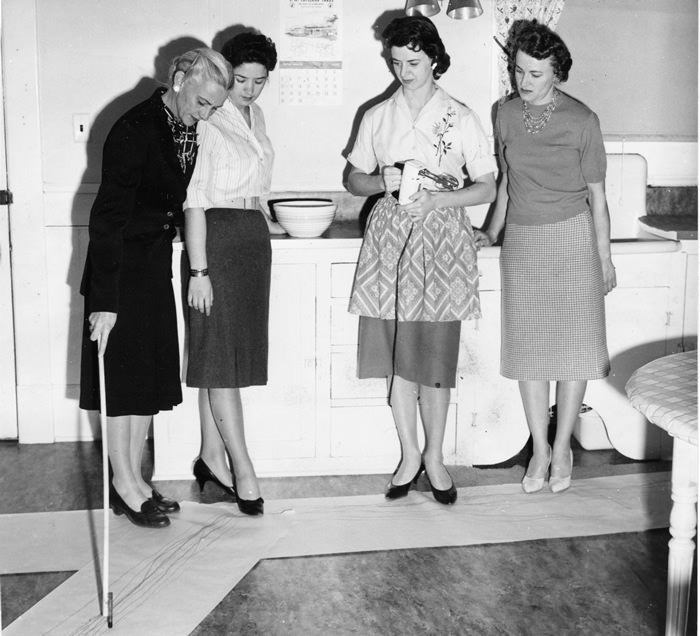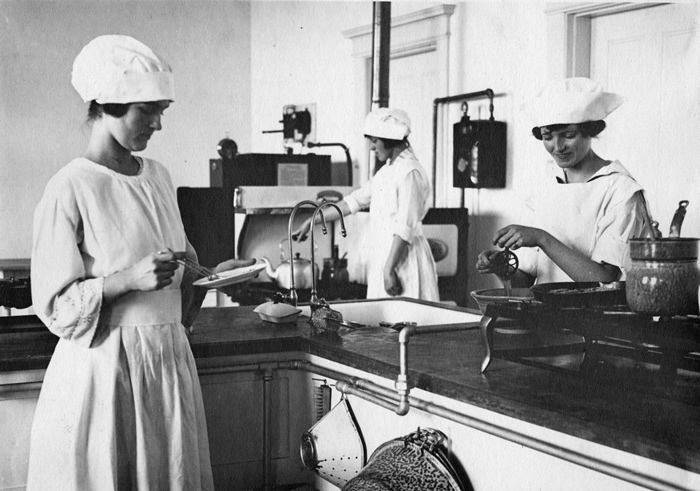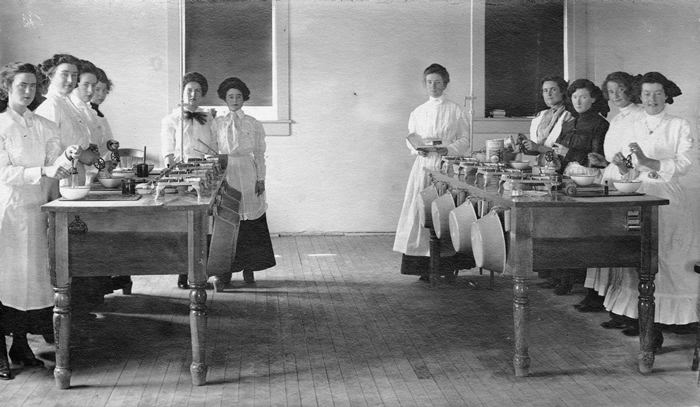edible traditions
BREAKING OUT OF THE KITCHEN
Unearthing the School of Home Economics.
WRITTEN BY SHARON HONIG-BEAR
Home Economics/Domestic Science Class, Stewart Hall, 1911
Even the words sound old fashioned: home economics. At a time when buzzwords in the food world include product development and engineering and safety, it’s easy to forget that their roots are in home ec. More than 100 years ago, the subject of home economics entered academia and brought women along with it. The rise and fall of the field closely parallels the roles of women in the kitchen and workplace.
In the late 1900s, the Cult of Domesticity, a value system in the U.S. and United Kingdom that emphasized the woman’s role as being in the home and family, dominated the landscape. In this environment, the University of Nevada, Reno, followed the national trend to start offering college courses in home economics. Starting in 1901, the Nevada State University (as UNR was called then) established the School of Domestic Art and Science. Its classes were taught in Stewart Hall as part of the College of Agriculture. Women were attracted to the courses but, unfortunately, couldn’t earn degrees for their efforts.

Extension agent Rose Goss and students map out efficient
ways to work around a kitchen in a home economics kitchen class, 1961
Legitimizing the field
Home economics needed a champion, and it found one in Martha Van Rensselaer. A trailblazing suffragette, county commissioner, and author, she co-founded the Department of Home Economics in 1912, at what is now Cornell University. Following her lead, in 1913, UNR renamed its program the School of Home Economics. Finally, students could earn Bachelor of Science degrees in the subject, with full academic credentials. The legitimization of the profession was an important step in women’s journey toward gender equality. Just one year later, in 1914, women attained full suffrage in Nevada.
Program flourishes
In his well-written article, UNR School of Home Economics: From Birth to Extinction, author Hugo Guillen continues the story. The School of Home Economics thrived during the 1920s and 1930s as people saw the relationship between a healthy household and an economically sound society.
Soon the school expanded its course offerings to include dietetics, interior design, and child development. As a final endorsement of the program, in 1957, university leaders approved construction of the Sarah H. Fleischmann School of Home Economics, so named for the wife of food industry executive Max C. Fleischmann, whose foundation provided funding for its construction. The new building arrived just in time to meet the growing demand for home economics teachers in the K-12 school system. A new generation of boys and girls was taught to cook and sew in the classroom, and at the same time witnessed the arrival of home economics as a profession.

Home Economics cooking laboratory, agriculture building (currently Frandsen Humanities), 1920
End of an era
This heyday was short-lived. No degree of planning could anticipate the radical cultural changes that swept across the U.S. during the 1960s and 1970s. The country suddenly found itself in the second wave of the women’s rights movement, challenging long-standing perceptions of gender roles. The stigma associated with home economics — perceived as keeping women tied to domestic life — finally caught up with the school. As enrollment declined for the first time in February 1989, the Board of Regents of the university transitioned the school into the new College of Human and Community Services. The Sarah H. Fleischmann School of Home Economics was formally closed, although courses still were offered in home economics, teacher education, nutrition, and interior design. In a final move in June 2010, the Board of Regents eliminated the Bachelor of Science degree in interior design, as part of the university’s budget reduction plan.
Leave it to the pioneer of the modern home economics movement to foresee the present food industry. Rensselaer famously said, “Home economics is not one department … it is not a single specialty … many technical and educational departments will grow out of it as time goes on.”
One can almost imagine her walking into a modern product development lab with a smile on her face.
Sharon Honig-Bear was the long-time restaurant writer for the Reno Gazette-Journal. She is a tour leader with Historic Reno Preservation Society and founder of the annual Reno Harvest of Homes Tour. She can be reached at Sharonbear@sbcglobal.net.


